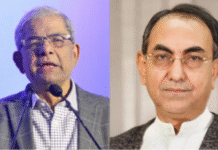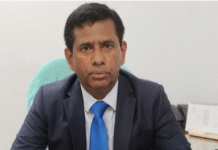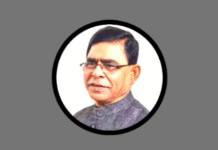Reporters Without Borders expressed Tuesday its concern over growing dangers to media workers, ranging from threats to murder. The worsening climate grows out of a trial of former leaders of Islamist parties accused of war crimes.
Pro-islamist blogs have posted threats to 19 bloggers. These come amid an already worsening climate for press freedom.
One blogger was savagely murdered this month. Previously, another was gravely injured by stab wounds. And on February 22, at least 23 journalists were injured during confrontations between Islamist militants and police that arose during street demonstrations prompted by the war-crimes trial, which centres on events during the 1971 war of independence from Pakistan.
“Threats and violence against media professionals and bloggers are unacceptable,” the press freedom organization said. “We deplore the fact that political party leaders and members are inciting hate against those covering a trial that raises issues of great importance to the country, exposing dark episodes from the country’s early history.”
Political parties should be trying to reduce tensions, RWB said, rather than inflame them.
Journalists covering the demonstrations, which have shaken the country, are caught between two forces: Islamists who don’t tolerate coverage of anyone who opposes them, and the authorities, who respond to demonstrations with gunfire, the press freedom organization said.
Threats by the Islamist party did prompt the government to shut down a number of Islamist websites, including sonarbangladesh.com. Some of the Islamists’ critics have continued speaking out despite the risks. But others, whose portraits have been disseminated, have gone into seclusion in fear for their lives.
Those fears are well-founded. On February 15, Ahmed Rajib Haider, 30, was found hacked to death near his home in the Palashnagar neighbourhood in a residential area of Dhaka, the capital. Previously, on January 14, Asif Mohiuddin, 29, was stabbed repeatedly outside his Dhaka office. He remains in critical condition.
On February 22, demonstrations organized by the Islamic party alliance led to clashes in which reporters and photographers were injured, many by gunfire from riot police.
The most serious incidents occurred in the southern city of Chittagong. After Friday prayer, Islamist militants broke into the press club office and the headquarters of the Chittagong Union of Journalists, accusing the journalists present of sheltering and praising demonstrators who demanded severe punishment of those responsible for war crimes during the 1971 conflict.
Photographers Kutub Uddin Chowdhury of Dainik Inquilab, Rajesh Chakrabarty of Dainik Jugantor and Miah Altaf of Dainik Purbakone were injured in the attack. So were Farid Uddin and Amit Das, reporters for the ATN Bangla television network, and Sanjeeb Babu and Rabiul Hossain Tipu, journalists with Machranga Television. Chowdhury is in serious condition at Chittagong Medical Hospital.
On February 23, the press organizations held a protest rally to publicize their condemnations of the attacks and their demand that those responsible be arrested.
In Dhaka, police deployed armoured cars, and used water cannons, pepper spray and tear gas in responding to a demonstration by Islamists at the Baitul Mukarram national mosque. At least 10 journalists were injured during the clashes that followed.
Islamists deliberately targeted journalists during that confrontation. Abdullah Tuhin, a correspondent for Machranga Television; Imran Tuhin, a reporter for ATN Bangla; Ferdous, a reporter for ATN News; and Mir Ahmed Miru, a photographer with Dainik Azmar Desh, were dragged into the mosque and attacked. Police eventually intervened and took the journalists to hospital.
In addition, Masadur Rahman, reporter for Gazi TV, Nurul Islam of the Independent Television network and Bangladesh Television (BTV), the state network; Arifuzzaman Pias of Ekattor TV; and Sayeed Bablu of Dainik Sangbad were wounded by gunfire.
Also in the capital, Aminul Islam Bhuiyan, elected member of the executive committee of Dhaka Reporters Unity (DRU), was hospitalized after suffering a rubber bullet wound to the leg.
In the north-eastern city of Sylhet, Shafiq Ahmed Sofi of Channel 24; Shihabuddin Shihab, a reporter for Boishaki Television; Alauddin of Channel S; Nurul Islam, a photographer for Dainik Uttorporbo; and Sohar Ahmad of Machranga Television were hospitalized with injuries.
One the same day before the demonstrations, Islamist militants attacked press photographers Nazmul Kabir Pavel of Bangladesh Pratidin and Sheikh Abdul Majid of Sylhet Sanglap. They were rescued by activists of an anti-Islamist party.
The street clashes were accompanied by a cyber-attack on February 22 on the website of the Daily Star, a national, English-language newspaper. Hackers who remain unidentified broke into the site to insert large headlines favouring Jamaat-e-Islami. The site had published a number of reports on violence by Islamists throughout the country. The Daily Star regained control of its site within hours.
On February 24, the Islamist alliance led by Khelafat Andolon threatened a boycott of media that he said misrepresented the conflict between Islamists and “atheist” bloggers. Laying down an ultimatum, the alliance demanded that the government arrest these bloggers for “blasphemy” or face demonstrations after Friday prayer on February 28.
On 25 February, a number of journalists and media organizations reported receiving telephone threats of unknown origin.
Bangladesh is ranked 144th of 179 countries in the 2013 Reporters Without Borders press freedom index.
Source: Eurasia Review









